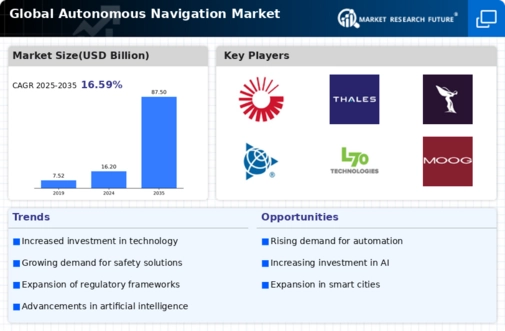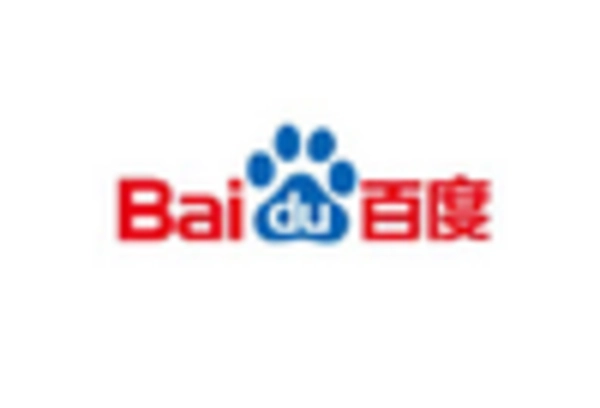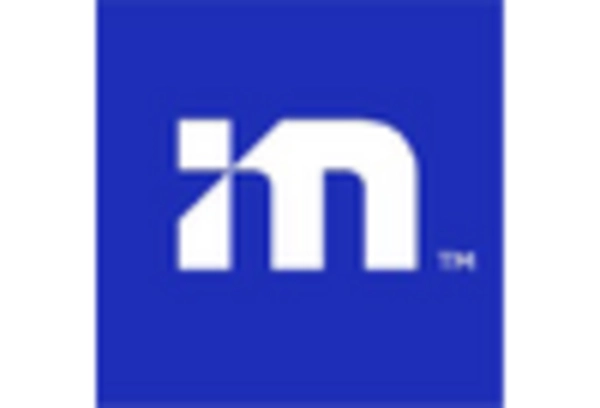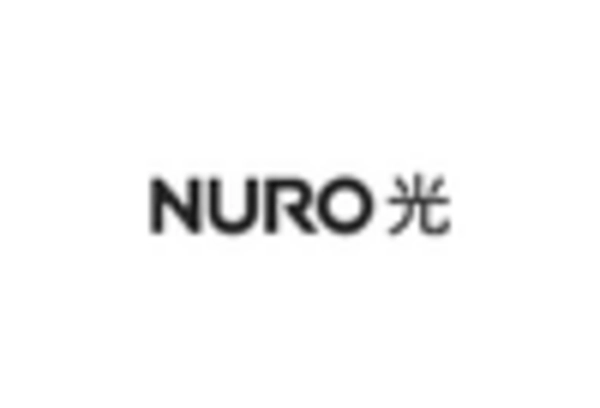-
Executive Summary
-
Market Attractiveness Analysis
- Global Autonomous Navigation Market, by Solution
- Global Autonomous Navigation Market, by Platform
- Global Autonomous Navigation Market, by Application
- Global Autonomous Navigation Market, by Region
-
Market Introduction
-
Market Definition
-
Scope of the Study
-
Market Structure
-
Key Buying Criteria
-
Market Factor Indicator Analysis
-
Research Methodology
-
Research Process
-
Primary Research
-
Secondary Research
-
Market Size Estimation
-
Forecast Model
-
List of Assumptions
-
Market Insights
-
Market Dynamics
-
Introduction
-
Drivers
-
Restraints
-
Opportunities
-
Challenges
-
Market/Technological Trends
-
Patent Trends
-
Regulatory Landscape/Standards
-
Market Factor Analysis
-
Value Chain/Supply Chain Analysis
- R&D
- Manufacturing
- Distribution & Sales
- Post-Sales Monitoring
-
Porter’s Five Forces Analysis
- Threat of New Entrants
- Bargaining Power of Buyers
- Threat of Substitutes
- Competitive Rivalry
- Bargaining Power of Supplies
-
Global Autonomous Navigation Market, by Solution
-
Introduction
-
Processing Unit
- Market Estimates & Forecast, 2020–2030
- Market Estimates & Forecast, by Region, 2020–2030
-
Sensing System
- Market Estimates & Forecast, 2020–2030
- Market Estimates & Forecast, by Region, 2020–2030
-
Software
- Market Estimates & Forecast, 2020–2030
- Market Estimates & Forecast, by Region, 2020–2030
-
Global Autonomous Navigation Market, by Platform
-
Introduction
-
Airborne
- Market Estimates & Forecast, 2020–2030
- Market Estimates & Forecast, by Region, 2020–2030
-
Land
- Market Estimates & Forecast, 2020–2030
- Market Estimates & Forecast, by Region, 2020–2030
-
Marine
- Market Estimates & Forecast, 2020–2030
- Market Estimates & Forecast, by Region, 2020–2030
-
Space
- Market Estimates & Forecast, 2020–2030
- Market Estimates & Forecast, by Region, 2020–2030
-
Global Autonomous Navigation Market, by Application
-
Introduction
-
Military & Government
- Market Estimates & Forecast, 2020–2030
- Market Estimates & Forecast, by Region, 2020–2030
-
Commercial
- Market Estimates & Forecast, 2020–2030
- Market Estimates & Forecast, by Region, 2020–2030
-
Market Estimates & Forecast, by Region, 2020–2030
-
Global Autonomous Navigation Market, by Region
-
Introduction
-
North America
- Market Estimates & Forecast, by Country, 2020–2030
- Market Estimates & Forecast, by Solution, 2020–2030
- Market Estimates & Forecast, by Platform, 2020–2030
- Market Estimates & Forecast, by Application, 2020–2030
- US
- Canada
-
Europe
- Market Estimates & Forecast, by Country, 2020–2030
- Market Estimates & Forecast, by Solution, 2020–2030
- Market Estimates & Forecast, by Platform, 2020–2030
- Market Estimates & Forecast, by Application, 2020–2030
- UK
- Germany
- France
- Italy
- Russia
- Rest of Europe
-
Asia-Pacific
- Market Estimates & Forecast, by Country, 2020–2030
- Market Estimates & Forecast, by Solution, 2020–2030
- Market Estimates & Forecast, by Platform, 2020–2030
- Market Estimates & Forecast, by Application, 2020–2030
- China
- Japan
- India
- Australia
- South Korea
- Rest of Asia-Pacific
-
Middle East & Africa
- Market Estimates & Forecast, by Country, 2020–2030
- Market Estimates & Forecast, by Solution, 2020–2030
- Market Estimates & Forecast, by Platform, 2020–2030
- Market Estimates & Forecast, by Application, 2020–2030
- UAE
- Israel
- Saudi Arabia
- Rest of the Middle East & Africa
-
Latin America
- Market Estimates & Forecast, by Country, 2020–2030
- Market Estimates & Forecast, by Solution, 2020–2030
- Market Estimates & Forecast, by Platform, 2020–2030
- Market Estimates & Forecast, by Application, 2020–2030
- Brazil
- Rest of Latin America
-
Competitive Landscape
-
Competitive Overview
-
Competitor Dashboard
-
Major Growth Strategies in the Global Autonomous Navigation Market
-
Competitive Benchmarking
-
Market Share Analysis
-
Northrop Grumman Corporation: The Leading Player in Terms of Number of Developments in the Global Autonomous Navigation Market
-
Key Developments & Growth Strategies
- Product Launches/Service Deployments
- Mergers & Acquisitions
- Joint Ventures
-
Company Profiles
-
ABB
- Company Overview
- Products/Services Offered
- Financial Overview
- Key Developments
- SWOT Analysis
- Key Strategies
-
Collins Aerospace
- Company Overview
- Products/Services Offered
- Financial Overview
- Key Developments
- SWOT Analysis
- Key Strategies
-
Furuno Electric Co., Ltd
- Company Overview
- Products/Services Offered
- Financial Overview
- Key Developments
- SWOT Analysis
- Key Strategies
-
General Dynamics Corporation
- Company Overview
- Products/Servies Offered
- Financial Overview
- Key Developments
- SWOT Analysis
- Key Strategies
-
Honeywell International Inc.
- Company Overview
- Products/Services Offered
- Financial Overview
- Key Developments
- SWOT Analysis
- Key Strategies
-
Kongsberg Group
- Company Overview
- Products/Services Offered
- Financial Overview
- Key Developments
- SWOT Analysis
- Key Strategies
-
L3 Technologies, Inc.
- Company Overview
- Products/Services Offered
- Financial Overview
- Key Developments
- SWOT Analysis
- Key Strategies
-
Moog Inc.
- Company Overview
- Products/Services Offered
- Financial Overview
- Key Developments
- SWOT Analysis
- Key Strategies
-
Northrop Grumman Corporation
- Company Overview
- Products/Services Offered
- Financial Overview
- Key Developments
- SWOT Analysis
- Key Strategies
-
Raytheon Company
- Company Overview
- Products/Services Offered
- Financial Overview
- Key Developments
- SWOT Analysis
- Key Strategies
-
RH Marine
- Company Overview
- Products/Services Offered
- Financial Overview
- Key Developments
- SWOT Analysis
- Key Strategies
-
Rolls-Royce
- Company Overview
- Products/Services Offered
- Financial Overview
- Key Developments
- SWOT Analysis
- Key Strategies
-
Safran
- Company Overview
- Products/Services Offered
- Financial Overview
- Key Developments
- SWOT Analysis
- Key Strategies
-
Thales Group
- Company Overview
- Products/Services Offered
- Financial Overview
- Key Developments
- SWOT Analysis
- Key Strategies
-
Trimble Inc.
- Company Overview
- Products/Services Offered
- Financial Overview
- Key Developments
- SWOT Analysis
- Key Strategies
-
Appendix
-
References
-
Related Reports
-
List of Abbreviations
-
Industry Insights
-
Note: This table of contents is tentative and subject to change as the research progresses.
-
-
List of Tables
-
Global Autonomous Navigation Market, by Region, 2020–2030
-
North America: Autonomous Navigation Market, by Country, 2020–2030
-
Europe: Autonomous Navigation Market, by Country, 2020–2030
-
Asia-Pacific: Autonomous Navigation Market, by Country, 2020–2030
-
Middle East & Africa: Autonomous Navigation Market, by Country, 2020–2030
-
Latin America: Autonomous Navigation Market, by Country, 2020–2030
-
Global Autonomous Navigation Market Size, by Region, 2020–2030
-
North America: Autonomous Navigation Market Size, by Country, 2020–2030
-
Europe: Autonomous Navigation Market Size, by Country, 2020–2030
-
Asia-Pacific: Autonomous Navigation Market Size, by Country, 2020–2030
-
Middle East & Africa: Autonomous Navigation Market Size, by Country, 2020–2030
-
Latin America: Autonomous Navigation Market Size, by Country, 2020–2030
-
Global Autonomous Navigation Solution Market, by Region, 2020–2030
-
North America: Autonomous Navigation Solution Market, by Country, 2020–2030
-
Europe: Autonomous Navigation Solution Market, by Country, 2020–2030
-
Asia-Pacific: Autonomous Navigation Solution Market, by Country, 2020–2030
-
Middle East & Africa: Autonomous Navigation Solution Market, by Country, 2020–2030
-
Latin America: Autonomous Navigation Solution Market, by Country, 2020–2030
-
Global Autonomous Navigation Platform Market, by Region, 2020–2030
-
North America: Autonomous Navigation Platform Market, by Country, 2020–2030
-
Europe: Autonomous Navigation Platform Market, by Country, 2020–2030
-
Asia-Pacific: Autonomous Navigation Platform Market, by Country, 2020–2030
-
Middle East & Africa: Autonomous Navigation Platform Market, by Country, 2020–2030
-
Latin America: Autonomous Navigation Platform Market, by Country, 2020–2030
-
Global Autonomous Navigation Application Market, by Region, 2020–2030
-
North America: Autonomous Navigation Application Market, by Country, 2020–2030
-
Europe: Autonomous Navigation Application Market, by Country, 2020–2030
-
Asia-Pacific: Autonomous Navigation Application Market, by Country, 2020–2030
-
Middle East & Africa: Autonomous Navigation Application Market, by Country, 2020–2030
-
Latin America: Autonomous Navigation Application Market, by Country, 2020–2030
-
Global Autonomous Navigation Market, by Region, 2020–2030
-
Global Autonomous Navigation Market, by Solution, 2020–2030
-
Global Autonomous Navigation Market, by Platform, 2020–2030
-
Global Autonomous Navigation Market, by Application, 2020–2030
-
North America: Autonomous Navigation Market, by Country, 2020–2030
-
North America: Autonomous Navigation Market, by Solution, 2020–2030
-
North America: Autonomous Navigation Market, by Platform, 2020–2030
-
North America: Autonomous Navigation Market, by Application, 2020–2030
-
Europe: Autonomous Navigation Market, by Country, 2020–2030
-
Europe: Autonomous Navigation Market, by Solution, 2020–2030
-
Europe: Autonomous Navigation Market, by Platform, 2020–2030
-
Europe: Autonomous Navigation Market, by Application, 2020–2030
-
Asia-Pacific: Autonomous Navigation Market, by Country, 2020–2030
-
Asia-Pacific: Autonomous Navigation Market, by Solution, 2020–2030
-
Asia-Pacific: Autonomous Navigation Market, by Platform, 2020–2030
-
Asia-Pacific: Autonomous Navigation Market, by Application, 2020–2030
-
Middle East & Africa: Autonomous Navigation Market, by Country, 2020–2030
-
Middle East & Africa: Autonomous Navigation Market, by Solution, 2020–2030
-
Middle East & Africa: Autonomous Navigation Market, by Platform, 2020–2030
-
Middle East & Africa: Autonomous Navigation Market, by Application, 2020–2030
-
Latin America: Autonomous Navigation Market, by Country, 2020–2030
-
Latin America: Autonomous Navigation Market, by Solution, 2020–2030
-
Latin America: Autonomous Navigation Market, by Platform, 2020–2030
-
Latin America: Autonomous Navigation Market, by Application, 2020–2030
-
-
List of Figures
-
Research Process of MRFR
-
Top-Down & Bottom-Up Approaches
-
Market Dynamics
-
Impact Analysis: Market Drivers
-
Impact Analysis: Market Restraints
-
Porter's Five Forces Analysis
-
Value Chain Analysis
-
Global Autonomous Navigation Market Share, by Solution, 2020 (%)
-
Global Autonomous Navigation Market, by Solution, 2020–2030 (USD Million)
-
Global Autonomous Navigation Market Share, by Platform, 2020 (%)
-
Global Autonomous Navigation Market, by Platform, 2020–2030 (USD Million)
-
Global Autonomous Navigation Market Share, by Application, 2020 (%)
-
Global Autonomous Navigation Market, by Application, 2020–2030 (USD Million)
-
Global Autonomous Navigation Market Share (%), by Region, 2020
-
Global Autonomous Navigation Market, by Region, 2020–2030 (USD Million)
-
North America: Autonomous Navigation Market Share (%), 2020
-
North America: Autonomous Navigation Market, by Country, 2020–2030 (USD Million)
-
Europe: Autonomous Navigation Market Share (%), 2020
-
Europe: Autonomous Navigation Market, by Country, 2020–2030 (USD Million)
-
Asia-Pacific: Autonomous Navigation Market Share (%), 2020
-
Asia-Pacific: Autonomous Navigation Market, by Country, 2020–2030 (USD Million)
-
Middle East & Africa: Autonomous Navigation Market Share (%), 2020
-
Middle East & Africa: Autonomous Navigation Market, by Country, 2020–2030 (USD Million)
-
Latin America: Autonomous Navigation Market Share (%), 2020
-
Latin America: Autonomous Navigation Market, by Country, 2020–2030 (USD Million)

















Leave a Comment